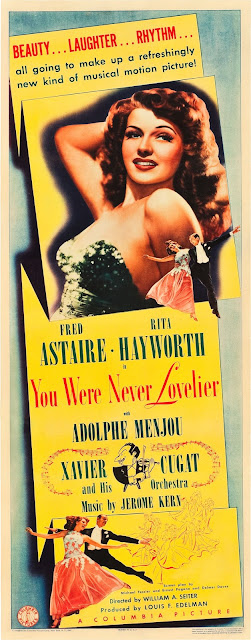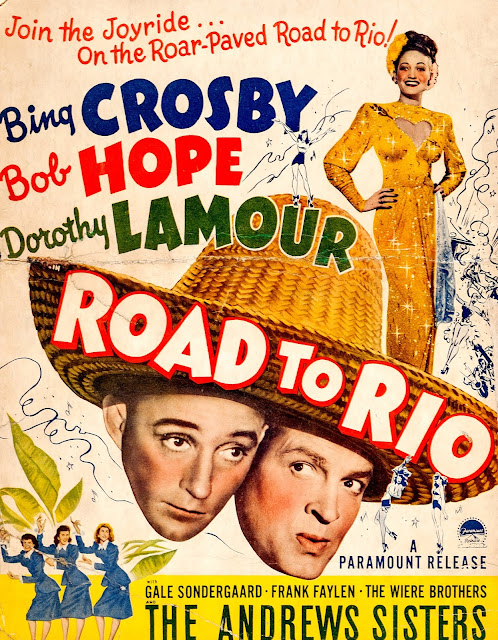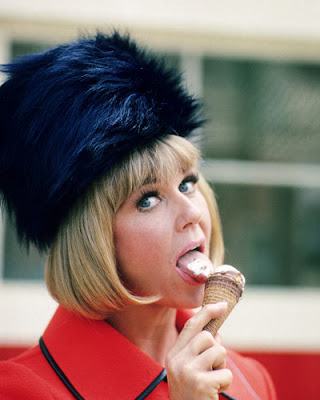The Sensuality of The Pirate (1948)
The Pirate may not have been appreciated when it was first released, but over the years, the film has become vindicated in its blend of lush production values, delightfully madcap performances from Judy Garland and Gene Kelly, and a charming Cole Porter score. The Pirate isn't going to be everyone's cup of tea, though. It's much too stylized and the characterizations are sure to be called "over-the-top." However, there is a subtlety that works with the louder moments to convey a sensuality that seems to go unnoticed. You might be thinking What are you talking about? This is the movie that gave us Gene Kelly in hot pants! Well, yeah. But there are other things bubbling beneath the surface that make The Pirate a film about sex.
It begins with Manuela (Garland) breathlessly talking about infamous pirate Macoco as she wonders where he is and what he is doing. Right away we see that Manuela longs for travel and romance, things that are denied her when her Aunt Inez (Gladys Cooper) informs her that she has been betrothed to Don Pedro Vargas, the town's mayor. Although Don Pedro is rich and an esteemed member of the community, he isn't exactly a dreamboat. (Sorry, Walter Slezak!) To make matters worse, he no longer cares for travel so Manuela is destined to be stuck in her small Caribbean village for a long, long time.
Manuela is told she is silly for wishing for whimsy and love. She is a testament to the idea that you can be sensible and still have an imagination. As she tells her aunt, "I realize that there's a practical world and a dream world. I know which is which. I shan't mix them." Aunt Inez scolds her for being ungrateful about her engagement to Don Pedro, especially when Manuela asks to go to Port Sebastian when her trousseau comes in so she can see the sea one last time. Aunt Inez reluctantly agrees to this, but as the film goes on, she lives to regret it.
For Manuela, the sea is magical -- unruly and wild, it can't be told what to do or who to be. The joy on her face as she watches the waves crash combines with the mounting music to mimic the dizzying adoration that Manuela feels.
While our heroine is gazing at the sea, traveling entertainer Serafin (Kelly) is gazing at her. Serafin is the ultimate ham. Obnoxious and brash, he rarely does anything with quiet dignity. For his first number, Serafin presents himself as the ultimate ladies' man. He's been with so many women, in fact, that he doesn't even bother learning their names, instead calling them "Nina." The resulting routine displays Serafin's libido, charm, and sex appeal. You can't tell me that Gene Kelly wasn't aware of the effect that he would have on female viewers with this song and dance.
He slinks his way around the village, entrancing women left and right. One inventive move sees him grab a lady's cigarette, take a puff while he takes her in his arms, flip the cigarette into his mouth, kiss her, and then flip the still-lit cigarette back out. It sounds weird, but it comes across as seductive, I swear. "Nina" is a lot of fun to watch. The lyrics are classic Cole Porter -- I mean, the man seamlessly integrates the word neurasthenia into the tune! Making the number even more memorable is Kelly's dancing. He saw the film's time period as a welcome challenge because tap dance hadn't been invented yet, forcing him to rely on ballet and Latin dances like the tango. Some people actually cite "Nina" as the first instance of pole dancing on film. I'm not sure if what he does qualifies, so you'll have to watch the scene for yourself here.
The moment when Manuela and Serafin meet is fascinating to me because of the way Vincente Minnelli staged it. (Minnelli always did a stellar job of this.) Manuela enters the frame, pausing to catch her breath when she first sees the Caribbean Sea. When she walks forward and out of the frame, the camera stays to reveal that Serafin was right behind her, stunned by her beauty. It's also the precise second when he exhales cigarette smoke, as if Manuela makes him literally hot under the collar.
The irony of their meeting is that Serafin is offering Manuela what she seems to want -- excitement, intrigue, passion -- but she is not amused. When she rejects his sudden proclamation of love, he remarks "Oh, I see. You find enough romance in daydreams. ... I know that underneath that prim exterior there are depths of emotion, romantic longings, unfulfilled dreams." Annoyed, Manuela walks off in a huff, but not before the wind blows off her white hat and soaks it in the mud. Is it a coincidence that her "pure" hat becomes sullied when she encounters the promiscuous Serafin? Probably not. You can see the scene here.
That night, her hotel room is unbearably hot. Opening the window, it's almost like Manuela has located the cause of the heat when she hears Serafin's show happening below. She decides to join the rapt audience, which pleases a smug Serafin to no end. Determined to demonstrate to her that she is attracted to him, he presents a spinning mirror that is described as an experiment in animal magnetism. The hyponitism works, but instead of declaring Serafin to be her object of affection, she lets loose her adoration of Macoco. "Someday he'll swoop down on me like a chicken hawk and carry me away!" she exclaims. When Serafin tries to regain control
of the situation by calling her "pure soul," Manuela snaps "Don't call me 'pure soul'! It irritates me!" She then begins repeating his comment from earlier that "underneath this prim exterior there are depths of emotion, romantic longings, unfulfilled dreams!" "I know. I'm here to release them," Serafin replies to no avail. Unable to keep quiet about her love for Macoco, Manuela bursts into "Mack the Black," illustrating that Serafin was right about what lies behind her rigidity. With her hair loose and her skirt swirling around to show off her legs, Manuela only endears herself more to Serafin. Originally, this number was supposed to be far more sexual, but MGM was horrified at the results. It has
been reported that Louis B. Mayer demanded the footage be burned immediately, so the only remnant of it seems to be audio of the song that "Mack the Black" replaced, "Voodoo." "Mack the Black" is still suggestive, though. The sexiest part of it might be the ending, when Serafin kisses Manuela to bring her out of the trance. Her body slowly gives in, making the kiss even steamier. Now awake, Manuela is horrified and runs back to her hotel to beg Aunt Inez to return home as soon as possible.
A week goes by and Manuela's wedding day has arrived. Told by Inez that "You can make anything come true by wishing hard enough for it," Manuela pulls out the hat she was wearing when she met Serafin and begins laughing to herself. When she hears the arrival of Serafin's troupe, it is like Manuela wished for the actor to appear, although she would never admit it. When he climbs into her bedroom, she tries to explain that she has "nothing but horror and shame" for her uninhibited performance the other night. "Horror? Shame? You were wonderful!" Serafin responds. Unlike everyone else, he encourages Manuela's "inappropriate" behavior; she would be suffocated otherwise.
Realizing that Don Pedro is Macoco, Serafin gets the idea to masquerade as the pirate to win Manuela's affection. Unaware that his fiancee is enamored with his alter ego, Don Pedro goes along with the scheme to keep his respectability intact. As Macoco, Serafin becomes calm, cool, and collected. His manic energy is brought down to a simmer, allowing Manuela to believe that he is the fierce, fearsome pirate she loves. It is hilarious to see Don Pedro watch in desperation as Serafin and Manuela make eyes at each other ("Do you two realize I'm in the room?!").
All it takes is one kiss on the hand from "Macoco" for Manuela to faint on the spot. Shortly thereafter, Serafin demands that the townspeople bring her to him or else he'll have his crew attack. Manuela pretends to nobly sacrifice herself, but really she couldn't be more thrilled.
Her enchantment is soon broken, however, when one of the troupers lets the truth slip out. Brimming with anger, Manuela gets her revenge by first playing along with Serafin. Echoing the way he kept circling her with wandering eyes by the sea, she walks around him and purrs "I want to gaze my full at you." The reversal makes Serafin fidget... and he hasn't even gotten the worst of it yet. Luring him into a room full of delicate treasures, Manuela unleashes her wild side, but it doesn't enthrall Serafin this time -- probably because it involves throwing anything and everything right at his head. It's such a magnificent scene. After knocking him out with a painting, Manuela feels remorse and realizes that she may just love the crazy actor after all. Singing "You Can Do No Wrong," she sweetly cradles Serafin's head in her lap and they embrace.
Furious with the liberties Serafin is taking as Macoco, Don Pedro is able to frame him for his crimes and gets him arrested. At his execution, Serafin convinces the viceroy (George Zucco) to let him put on one final show. After mystifying everyone with the jaw-dropping acrobatics of "Be a Clown," Serafin brings out his spinning mirror to hypnotize Don Pedro into admitting that he is the real Macoco. When Aunt Inez breaks the mirror, Manuela is forced to improvise and pretends to be under the mirror's spell.
Gushing about her love for Macoco and vowing her devotion, she sings "Love of My Life" as Don Pedro becomes increasingly jealous. Garland and Kelly drape themselves over each other, making the number incredibly tender and erotic. When the song ends with Manuela and Serafin sharing a kiss, Don Pedro can stand it no longer. He loudly shouts that he is the true Macoco, telling Manuela "If you want to worship Macoco, worship me!" As you can probably guess, Don Pedro doesn't quite get the happy ending he wants -- but Serafin and Manuela do!
Of course, I couldn't end this post without talking about the scene that makes The Pirate so blatantly sexual: Manuela's fantasy sequence. After discovering that Serafin is Macoco, Manuela watches him from her bedroom window and begins imagining him in full piratical action. Reality becomes blurred as Serafin is transformed into a dastardly buccaneer decked out in all black -- and the shortest of shorts. God, I wish I could have been there for that costuming meeting. ("No, shorter! And let's add a V-neck to the shirt!") According to his widow, Patricia Ward Kelly, Gene purposely chose tight clothing for a lot of his costumes. It showed off his physique, proving that dancing required insane
athleticism. It also made him into eye candy, which he didn't seem to mind. Out of all of his routines, this one gave Gene the most fan mail.
It isn't hard to see why. The number may be ridiculous and slightly cheesy, but Kelly sells the hell out of it. Channeling heroes Douglas Fairbanks and John Barrymore, Kelly is graceful, attractive, and captivating. One second he is swinging in the air, the next he is whipping around a sword with abandon. I would love to know what audiences back then thought of this number. Was it too
outlandish? Too sexual? Too silly? Personally, I can't help but smile when I watch it. If you take this film 100% seriously, especially this scene, you're doing yourself a great disservice. Just watch the ballet here and tell me you didn't find yourself grinning.
The Pirate is a giddy, crazy film. I can't guarantee that you'll love it, but you can at least appreciate the craftsmanship that went into it. Everything about it is top of the line. You're not liable to see anything else quite like it. Simply put, to me The Pirate can do no wrong.
__________________
This post is my entry to the Third Annual Sex! (Now That I Have Your Attention) Blogathon. You can find the complete roster here.








































Great review! You're right; it's really a steamy musical.
ReplyDeleteWhen I first saw it, it was so different from what I was expecting that I was rather taken aback, though fascinated. I think it's time I saw it again, though!
Thanks! Gene Kelly always brought a lot of sex appeal to his films, but I think we forget that Judy could too. The Pirate showcases that.
DeleteGreat post about the sexuality in this movie. I just a post on this movie too; but, my focus was on Judy and the pirate theme. This was perfect with the focus on Kelly and its sexual overtones.
ReplyDeleteThank you! I remember your post -- it was very good! As you can see, I loved one of the posters you included in your piece. It can be hard finding a unique poster that not everyone has seen over and over again. (I thought I linked the image to your post, but it looks like I forgot. I'll fix that as soon as I can!)
DeleteGreat review and analysis of "The Pirate". It's one of my favorite movies and Gene Kelly is a whirling dervish of talent and sex. Another thing that makes the ending of "Mack The Black" so erotic is the infamous breast brush that Gene Kelly lays on Judy Garland. I've never seen anything like that in any MGM musical and have no idea how that moment passed the censor.
ReplyDeleteThanks for the comment! I'm not sure how a lot of this film got past the censors. It's quite racy for old Hollywood standards! But that's why we love it.
DeleteHi! I found this blog by chance looking for the images of the movie "The Pirate" on Google, with Judy Garland and Gene Kelly that I saw just last night. I'm an Italian fan of Judy and Gene and this post you made on the film is very nice and accurate, congratulations! :) I agree, for those years the film was really projected ahead and people did not understand it because they were not ready yet. It happens to the great artists, as were Judy, Gene and Minnelli. The artists are always projected towards the future, towards the new, but now it has been rediscovered and is considered a classic! The chemistry between Judy and Gene is fabulous in the film! they were a wonderful couple on the big screen! They shot three films together but I wanted to see them in more movies! They remained close friends for a lifetime and Gene never forgot Judy's help in filming her first film together, "For Me and My Gal" (1942). This thing makes me love them even more! She agreed to shoot their third film together, "Summer Stock" (1950) to help her recover from a difficult period and to thank her for all the love and help she had from her. During the filming he was always patient and kind and helped him in every possible way. They were really sweet together, a pure and fantastic friendship! I apologize for my English, I'm Italian and I hope I have not made mistakes! Ciao! :)
ReplyDeleteThank you for such a great comment! It's true that Judy and Gene were each other's champions. Their collaborations are special, and it's so sweet that Gene was there for Judy when she needed it during Summer Stock. It is a shame they didn't make more movies together. So glad you found my blog and that you enjoyed this post! :)
DeleteGene and Judy were supposed to make "Easter Parade" together and Gene had already choreographed a lot of the dances, then the darn fool broke his ankle playing Volleyball. Oh, what might have been. Astaire's great but he was never the actor that Kelly was and brings no heat to the lovemaking. When the couple is strolling down Fifth Avenue and he produces an engagement ring, it should be a lovely, romantic moment, but Fred looks like Judy's kindly uncle, not her lover. We could have had four Kelly/Garland masterpieces!
ReplyDeleteFred and Gene were such different performers and dancers, and I think that really shows in the work they did with mutual partners, like Rita Hayworth and Judy. Easter Parade is one of my great favorites, partly because it is the sole collaboration between Fred and Judy and I think they were superb together, but I definitely see your point. It would've been a much different film with Gene in the lead, that's for sure! I'll also say that I think his chemistry with Judy was helped by the fact that he worshipped her as a person and they shared a special bond that she didn't have with Fred (although he also thought she was tremendous).
DeleteThanks for reading!
"Oh my" is right! Thanks for reading!
ReplyDelete